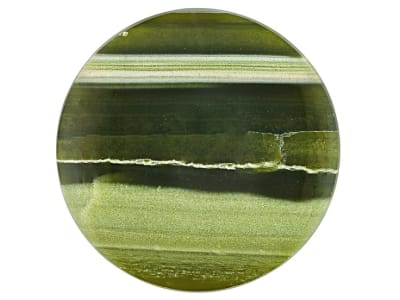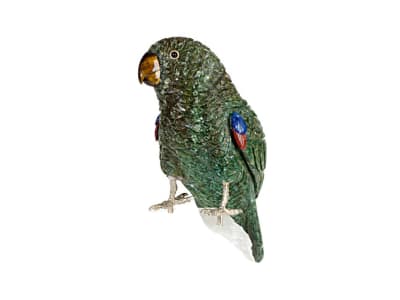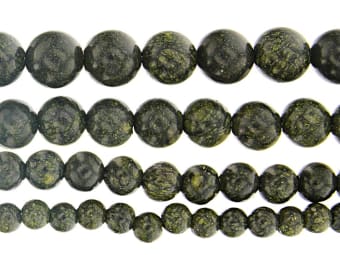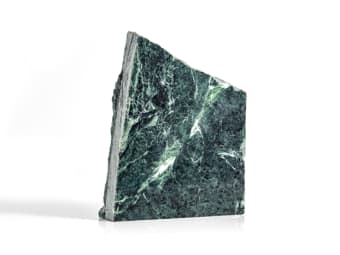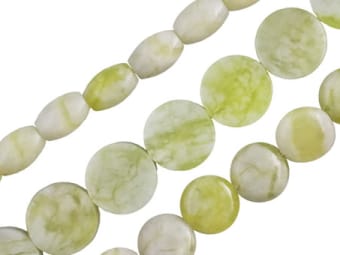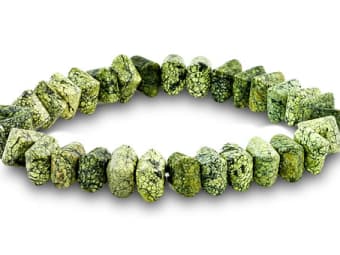Serpentine is well known to the world's mineralogists and gemologists, but is much less familiar to the general public. The marbled look of this green stone makes it ideal as an ornamental material, and it has been carved into a wide array of decorative objects throughout history. Although serpentine has a similar appearance to jade, it is a different, unrelated series of minerals.
General Information
LWUV: Inert to weak green
Serpentine Colors
-
 Black
Black -
 Brown
Brown -
 Gray
Gray -
 Green
Green -
 Green
Green -
 Multi-color
Multi-color -
 Orange
Orange -
 Pink
Pink -
 White
White -
 Yellow
Yellow
Alternate Names
Antigorite, Bowenite, Williamsite, Verd-Antique, Bastite, Chrysotile
Countries of Origin
Afghanistan; Russian Federation; United States of America; Madagascar; United Kingdom of Great Britain and Northern Ireland; Congo; India; Greece; New Zealand; Canada; Austria; Pakistan; Unknown; China; Brazil; Italy; South Africa; Australia
Care
Serpentine is very soft, so be mindful of scratching. Avoid sudden temperature changes, chemicals, and ultrasonic cleaners. Requires gentle handling
Species/Variety
Lizardite
Lizardite is a common component in serpentine rocks and it is named for Lizard Peninsula in Cornwall, England where it was first discovered. It is often used for decorative objects and beads for jewelry.
Williamsite
Williamsite is a semi-transparent to translucent variety of antigorite, a mineral in the serpentine group. Williamsite was named in honor of 19th century American mineral collector L.W. Williams, who first discovered it. With a range of green hues, its color has a marked resemblance to two more expensive gems, jade and chrysoprase, and is used as a simulant of both. Williamsite exhibits an oily luster when polished and often contains minor inclusions of chromite and magnetite.
LWUV: Weak whitish-green
Verd Antique
Verde-antique is a name applied to serpentine rock that exhibits veins of minerals, such as calcite, dolomite, and magnesite. The material is a dark green with a mottled appearance due to various mineral inclusions. Verde-antique has been a popular decorative stone for thousands of years.
Chrysotile
Chrysotile, a fibrous form of serpentine, is also a major source of asbestos worldwide. Its color ranges from white to gray, yellowish brown to brown, and shades of green. Chrysotile has a fibrous, splintery fracture, no cleavage and silky luster. Chrysotile is used most commonly for industrial purposes.
Bowenite
One of the most common serpentine varieties in the gem trade is bowenite, one of the hardest of the serpentine minerals. It is a massive variety of antigorite that ranges from blue-green to green and green to yellow. It is translucent to semi-translucent, and has been used in various types of jewelry, as well as in decorative and ornamental applications.
Antigorite
Antigorite is a hard, compact variety of serpentine occurring either in corrugated plates or fibers. Serpentine is well known to mineralogists and gemologists, but is much less familiar to the general public. Often similar to jade in appearance, it is primarily used an ornamental material and has been carved into a wide array of decorative objects throughout history. Antigorite is usually green, but may be yellowish, gray, brown or black.
Ricolite
Ricolite is a banded rock containing serpentine minerals and talc. Ricolite is named for a find in Rico, New Mexico, but the material has also been found in Mexico.
Connemara Marble
Ireland’s unofficial national gemstone, Connemara marble is a calcite marble that contains large amounts of serpentine. Green in color, its name comes from the locality in western Ireland where it is mined. Mining of this ornamental rock is one of Ireland’s oldest industries and there’s even a visitor’s center devoted to this decorative stone. The perfect stone to represent Ireland, which has long been known as the ‘Emerald Isle’, Connemara marble has been carved into a wide variety of decorative items throughout history. Known since the Stone Age, Connemara marble has also been used over the centuries as a medium of exchange.
